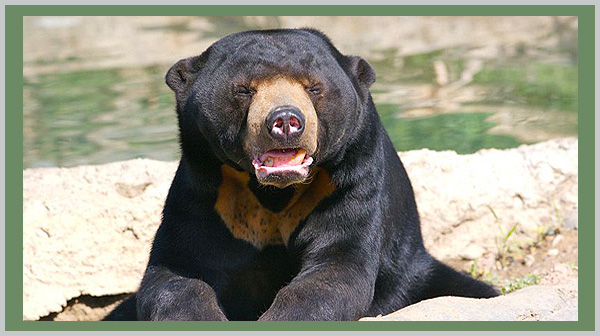Malayan Sun Bear
Name: Malayan Sun Bear (Helarctos malayanus)
Conservation Status: Vulnerable (2021 IUCN Red List)
Population Estimate: Decreasing
Range: Southeast Asia
Threats: Agriculture / Transportation / Energy Production / Hunting / Asian Medicine
The smallest bear in the world, an adult male Malayan sun bear is about 4 feet (1.2 m) tall when standing on its hind legs and can weigh up to 140 pounds (64 kg). Despite their small size, sun bears can be very dangerous. Named for the golden crescent, or “U” shaped golden patch on their chest, Malayan sun bears are otherwise all black with smooth, short fur.
Species Description and Natural History
Malayan sun bears are are increasingly rare residents of tropical rainforests in southern China, Burma, Malaysia, Sumatra, Laos, Cambodia, Vietnam, and Borneo.
Sun bears are skillful climbers, aided by long sickle-shaped claws on all four feet. These extremely long claws — up to six inches — allow the bears to dig for honey and grubs, which they lick up using their long tongues. The bears are omnivores. Their diet also includes fruits, insects, small mammals, and birds.
Malayan sun bears sometimes will damage coconut palm, banana, and cocoa plantations through foraging. They usually are nocturnal creatures. Smell is the sun bear’s most important sense and their eyesight is not very good.

Causes of Endangerment
Many bear species suffer from excessive killing and dramatic habitat loss worldwide. There are eight species of bears in the world: Malayan sun bear, Asiatic black bear, spectacled bear, American black bear, giant panda, sloth bear, polar bear, and brown bear.
The northern brown bears have been eliminated from half their former range. Certain Asian bear species are struggling to survive with 75 percent of their former habitat gone. Even the polar bear, seemingly isolated in the Arctic, may be threatened by pollutants in the food chain and proposed oil development in denning areas.
Habitat Loss
The majority of the Malayan sun bear’s forest habitat has been destroyed by logging and conversion to agriculture. In addition to leveling the forest, logging roads create convenient access for poachers. As natural food sources disappear, sun bears are driven by hunger to forage for food on farms and plantations, where they are shot or trapped by angry farmers.
Overexploitation
The demand for bear products is the greatest threat to all bears. Traditional Asian medicine prescribes bear fat, gall, meat, paws, spinal cord, blood, and bones for complaints ranging from baldness to rheumatism. Bear entrees are popular in restaurants, and sun bear paws are favored in Taiwan for soup.
The trade in bear gall in particular is so highly profitable that it has been likened to the heroin trade, as dried gall can sell for 18 times the price of gold.
In addition, Malayan people often keep sun bears as pets. The mother bears are killed in order to obtain cubs young enough to tame.
Conservation Actions
Trade Regulation
Although many countries have banned trade in bear products, the governments of South Korea and Taiwan, home to some of the most devoted consumers of bear products, are not parties to CITES.
Properties of bear products is so firmly rooted in some cultures it is virtually impossible to change. A more concentrated and effective synthetic version of one ingredient of bear gall is widely available and less expensive, but its availability has not reduced the demand for bear gall.
Captive Breeding
The Chinese have developed a way to extract bile from the gallbladders of live bears. In 2021 an estimated 12,000 bears are farmed for their bile. Descended from wild-caught individuals, the farm bears are now captive-bred. This effort is driven more by economics than concern for the animals. More than 100 times the bile can be obtained by milking a live bear than by killing one.
Government officials claim that farming has slowed the killing of wild bears, but critics contend it actually promotes the use of bear products and makes them available to more people (see also Tigers In Crisis).
All eight species of bears can be found in zoos around the world. The Malayan sun bears are part of an international captive-breeding program and a Species Survival Plan under the Association of Zoos and Aquariums since late 1994.
Question for Thought
Some people have suggested trying to change Asian peoples’ belief in the medicinal value of animal parts in order to reduce poaching. Do you think this is the right approach?
What do you think of the idea of raising Malayan sun bears on farms to provide bile and gall? Does this practice help or hinder the survival of wild sun bears? Do you consider farming sun bears to be different from raising domestic animals, such as cattle or chickens?
Explore:
Related Classroom Activities
[CS1-1,CS1-4, CS2-2, General]
Click here for Endangered Species Classroom Glossary